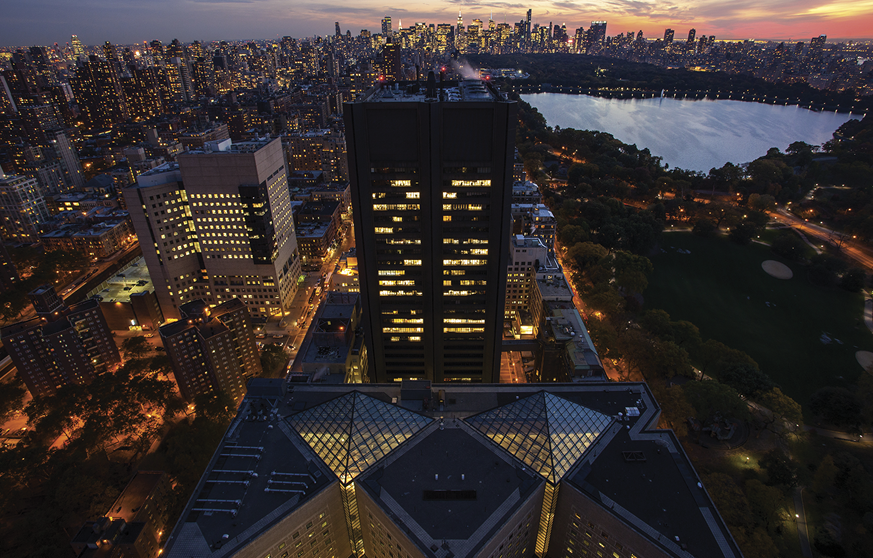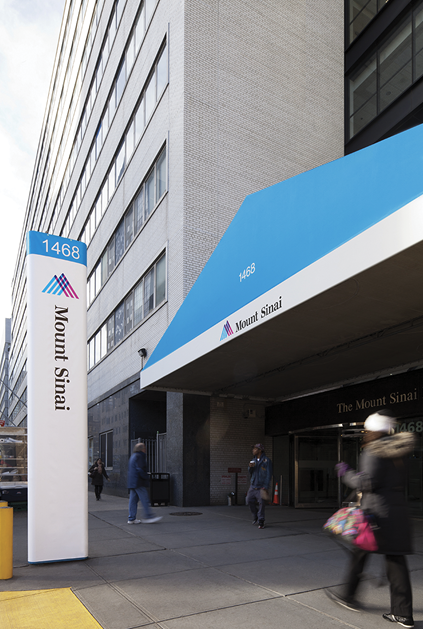- Home
- Media Kit
- MediaJet
- Current Issue
- Past Issues
- Ad Specs-Submission
- Ad Print Settings
- Reprints (PDF)
- Photo Specifications (PDF)
- Contact Us
![]()
ONLINE
![]()
ONLINE

Physician Leadership
Editors’ Note
David L. Reich, MD, the Horace W. Goldsmith Professor of Anesthesiology, Professor of Artificial Intelligence and Professor of Pathology, has been President of The Mount Sinai Hospital and Mount Sinai Queens, both part of the Mount Sinai Health System, since 2013. Dr. Reich was chairperson of the Department of Anesthesiology from 2004-2014 and also served as President of the Medical Board in 2011-2012. Prior to his anesthesiology training, Dr. Reich completed two years of residency in general surgery at Harbor/UCLA Medical Center in Torrance, California. He received his BS degree with highest distinction from Pennsylvania State University and his medical degree from Jefferson Medical College in Philadelphia. After arriving at Mount Sinai in 1984, Dr. Reich completed a residency in anesthesiology and a fellowship in cardiothoracic anesthesia. His honors include the 2011 Physician of the Year from Mount Sinai Nursing, the 2014 Mount Sinai Alumni Association Jacobi Medallion, the 2021 Heart of Gold Award from the NY Heart Association, the 2021 August Heckscher Founder Award for Community Service from CIVITAS, the 2021 Empire Whole Health Heroes Award from Empire BlueCross Blueshield and Crain’s New York Business, and Pace University’s 2022 Changemakers in Healthcare Award. Dr. Reich’s research interests include neurocognitive outcome following cardiac surgery, medical informatics, and hemodynamic monitoring. An academic cardiac anesthesiologist, he has published more than 200 articles, editorials and book chapters. As a hospital executive, he has enhanced safety and quality by forming an institute for critical care medicine, rapidly deploying AI-enhanced clinical decision support, and leading in COVID-19 care and diagnostics.
Institution Brief
Mount Sinai Health System (mountsinai.org) encompasses the Icahn School of Medicine at Mount Sinai and eight hospitals, as well as a large and expanding ambulatory care network. The eight hospitals – Mount Sinai Beth Israel, Mount Sinai Brooklyn, The Mount Sinai Hospital, Mount Sinai Queens, Mount Sinai Morningside, Mount Sinai South Nassau, Mount Sinai West, and New York Eye and Ear Infirmary of Mount Sinai – have a vast geographic footprint throughout the New York metropolitan region. The Mount Sinai Hospital is ranked number 17 in the nation by U.S. News & World Report. The New York Eye and Ear Infirmary of Mount Sinai is also ranked nationally in ophthalmology.

The Mount Sinai campus in New York City’s Upper West Side
What have been the keys to the strength and leadership of Mount Sinai Health System?
I think the key issue is physician leadership. Mount Sinai has a tradition going back to its beginnings of having strong physician leadership at the medical board and the hospital leadership levels. Physicians think about things a little differently, with prioritization at a more patient-focused level. Physician leadership has been extended as we became a health system. This has been an important part of the strength of Mount Sinai.
How important is it for you in your role to still find time to be with patients?
I am lucky in this regard as a cardiac anesthesiologist with a few decades of experience. I go into the operating room several days per month to educate a resident physician and provide anesthesia care for patients undergoing cardiac surgery. This is very helpful in centering me and reminding me about what is important. Directly experiencing the challenges that people are facing on the front lines of healthcare provides perspective.
Mount Sinai has been on the front lines in addressing the global pandemic. Will you discuss how Mount Sinai adapted the way it works to meet this challenging time?
As a health system, we came of age during the pandemic. We are eight hospitals. Learning to function as a health system rather than a confederation of individual campuses was a moment of maturation for us. We honed our capabilities to take the sickest patients from Queens or Brooklyn and bring them into Manhattan for care; we figured out how to coordinate supplies to move ventilators that were assembled by medical students at The Mount Sinai Hospital to all of the hospitals in the health system; and we synchronized our thinking around protocols of patient care. I am very proud that Mount Sinai was the first health system to recognize and treat clotting problems that were occurring with COVID. We were the first in the world to my knowledge to develop the use of blood thinners to improve the care of patients that were in the hospital due to severe COVID and this treatment has persisted to this day.
We are also focused on the health and well-being of our staff at all levels of the organization who have shown such strength and resilience during this unprecedented time. Our CEO and our Dean are both academic psychiatrists. At the very beginning of the crisis, they realized that our staff were experiencing psychological trauma by seeing people dying at high rates and in isolation. Since family members were not able to visit the hospital, our staff were there to hold patients’ hands and try to comfort them in their final moments. We created the Mount Sinai Center for Stress, Resilience and Personal Growth, a first-of-its-kind initiative in North America, that is designed to address the psychosocial impact of COVID-19 on the mental health and lives of frontline healthcare providers at Mount Sinai. We believe this will serve as a model for institutions and communities around the globe.
“Physician leadership has been extended as we became a health system. This has been an important part of the strength of Mount Sinai.”
Will you highlight Mount Sinai’s focus on providing seamless service and a consistent level of care throughout the health system?
During the worst of the pandemic at one of our hospitals in Brooklyn, several members of its leadership team and many frontline staff became ill and patient care conditions were deteriorating. We were able to bring staff from all over the health system to fill the need and create the support system until the leadership and staff were able to return to work and resume their regular functions. This is one example of how we are able to work together and leverage the talent throughout the system to address unforeseen challenges. This can only happen when the culture and talent throughout the health system is aligned and able to provide the high-level, quality care that Mount Sinai is known for.
What will the hospital of the future look like and what role will it serve?
The hospital of the future will have fewer beds, and the proportion of those beds will be very heavily weighted towards critical care and the next level down, intermediate care beds. Many people have medical needs and treatments that can be managed in the home. We have already run a pilot hospital-at-home program where we administer IV fluids and medications and staff come to the home two or three times a day to check on the patient. Another area is telemedicine, which has come of age during the pandemic as well as videoconferencing and video consultations. The advances in technology have provided great opportunities to provide high-level care outside the four walls of a hospital, improving value by delivering world-class care at a reduced cost.
It will be necessary for the hospital of the future to have the capabilities in case of a crisis to adapt nimbly to the needs of the time, which is a lesson learned from the pandemic.

The Mount Sinai Hospital
Do you worry that the emphasis on technology will take away from the human touch and the doctor/patient relationship?
A personal touch does not have to involve a doctor or nurse being physically present. A personal touch can occur in many ways. The most important way is that a person feels cared for and that there is continuity of care. If a person is in a hospital-at-home setting and the nurse comes two to three times a day at a specific time to check on them, they have that assurance, and if they are attached to a video monitor they know they can reach out at any time for assistance. Chronically ill patients can receive more effective preventive care and avoid hospital admissions with a combination of ambulatory care, care in the home, and video visits. It is the ways we use the technology that makes it personal or impersonal.
What do you see as the advantages of having a medical school and a hospital on the same campus?
The Mount Sinai Hospital is blessed to have a medical school and a hospital on a single campus. The physical unification of science and medicine translates into unified purpose, as we saw with the huge strengths in diagnostic, therapeutic and scientific advances that Mount Sinai made during the pandemic. The vision of the founders of the school in the 1960s continues to be a strength and a differentiator for us.
How important is it for the workforce at Mount Sinai to mirror the diversity of the patients it serves?
It is a long pathway to have the diversity of our patient population match the diversity of our staff, especially at the senior faculty and leadership levels. We have a roadmap and excellent pipeline and mentoring programs to address this. Our talent acquisition is focused intently on promoting equity in gender, race and ethnicity to bring diversity to the leadership level as people move up the ladder. A great effort at Mount Sinai is the Black Executive Acceleration Program, which uses a structured program of individual and group mentoring by senior leaders to help our staff in advancing their careers.
With all of the challenges facing healthcare, are you optimistic that the industry will be able to meet the challenges of the future?
The United States has advantages and disadvantages when it comes to the future of healthcare. We don’t have universal health insurance and it is very unlikely that this will happen anytime soon, based on the political climate. However, looking at Europe and other parts of the world where they have universal healthcare, it is far from perfect in many respects. Philosophically, we need to radically change our systems by focusing on the triple aim of providing access to care, a good experience of care, and value-based care. Part of this has to do with improving social services and getting out into the community to do screenings. If we adapt as a society to see the inherent value of preventive care, we can achieve a future with improved health at a lower cost.![]()